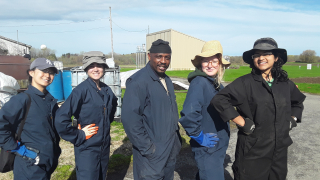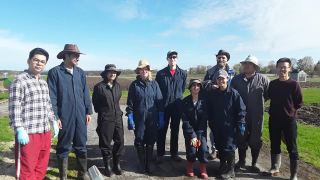Principal Investigator
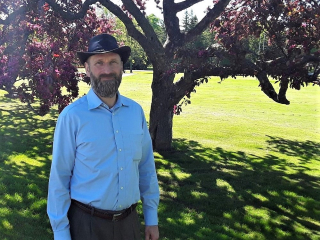 Prof. Grant Clark
Prof. Grant Clark
Associate Professor, Dept. of Bioresource Engineering, McGill University
T: 514-398-7784 | grant.clark [at] mcgill.ca (Email) | Macdonald-Stewart Building, MS1-099
Grant Clark is an Associate Professor in the Department of Bioresource Engineering at the Macdonald Campus of McGill University, and leads the Ecological Engineering Research Group. He is interested in flows of material and energy through the circular bioeconomy, and the best management of those flows to sustainably supply ecosystem services. His research group investigates different chamber deployment techniques and models GHG emissions under different climatic, soils, cropping and biosolids management scenarios. The research will generate emissions factors that necessary for quantifying and reporting emissions in Canada. Dr. Clark provides the oversight of his own research group and the activities of other researchers involved in the AGGP2-033 project.
For his full biography, visit his Bioresource Engineering Faculty profile.
Co-Principal Investigators
Prof. Joann K. Whalen
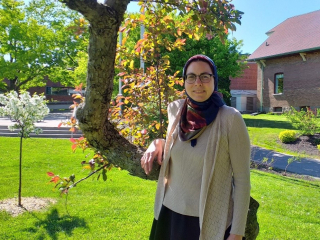 Professor; William Dawson Scholar; Dept. Natural Resource Sciences, McGill University
Professor; William Dawson Scholar; Dept. Natural Resource Sciences, McGill University
T: 514-398-7943 | joann.whalen [at] mcgill.ca (Email )| Macdonald-Stewart Building, MS2-069 | Website
Joann Whalen is a Professor in the Department of Natural Resource Sciences at McGill University. She is investigating how different types of biosolids influence the physical structure and chemical properties of soils and the response of soil microbes. Soil microbial activity is responsible for the decomposition and nutrient release from biosolids, as well as crop nutrition and stress tolerance. Greenhouse gases are released as a byproduct of decomposition and nitrogen cycling, and these are quantified using non-steady state chambers and gas chromatography.
For her full biography, visit her Natural Resource Sciences Faculty profile.
Prof. David Burton
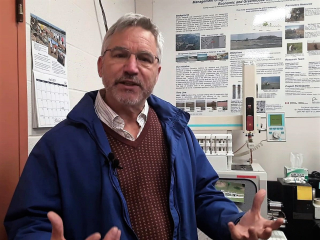 Professor, Dept. of Plant, Food, and Environmental Sciences, Dalhousie University
Professor, Dept. of Plant, Food, and Environmental Sciences, Dalhousie University
dburton [at] dal.ca (Email) | Dalhousie University Profile
Dr. Burton is a Professor in the Department of Plant, Food and Environmental Science at Dalhousie University. In Atlantic Canada, carbon availability is one of the strongest determinants of greenhouse gas emissions, especially N2O. His research group is investigating how anaerobically digested, lime-stabilized and composted biosolid influence the dynamics of carbon and nitrogen availability during the growing season. The release of nitrogen to the soil and how this is timed with regards to the supply of nitrogen to the soil is critical from a greenhouse gas as well as nutrient availability perspective. He is supervising a Master’s student, Gurwinder Singh.
Prof. Gordon W. Price
 Associate Professor, Dept. of Engineering, Dalhousie University
Associate Professor, Dept. of Engineering, Dalhousie University
gprice [at] dal.ca (Email )| Dalhousie University Profile
Dr. Price, PAg. is an Associate Professor for the Innovative Waste Management Research Program in the Department of Engineering at Dalhousie University. Municipal biosolid use in agro-ecosystems is a common practice for recycling of urban organics into soils. While this management approach can provide short-term benefits to farmers and municipal wastewater managers, the long-term effects on soil quality, or health, nutrient cycling, and greenhouse gas emissions is an important area of study. His research interest is understanding ecosystem impacts from the use of different urban organics, including biosolids, especially as it relates to effects in the soil.
Prof. Guillermo Hernandez-Ramirez
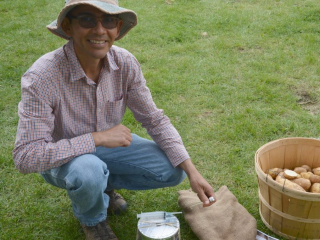 Associate Professor, Department of Renewable Resources, University of Alberta
Associate Professor, Department of Renewable Resources, University of Alberta
ghernand [at] ualberta.ca (Email) | University of Alberta Profile
Dr. Hernandez-Ramirez leads the Sustainable Land Ecosystems Research Group at the University of Alberta. As a group, the research interests and foci encompass carbon, nitrogen and water cycling and dynamics in land ecosystems including croplands, grasslands, forests and alpine. For example, we examine sources, transformation, utilization, behavior, fate, and fluxes of carbon and nitrogen in land ecosystems (often also called agroecosystems) with particular focus on the relative responses, controlling factors, and feedbacks of greenhouse gas exchange and soil carbon sequestration to common and improved management options.
Research Associate
Dr. Michael Boh
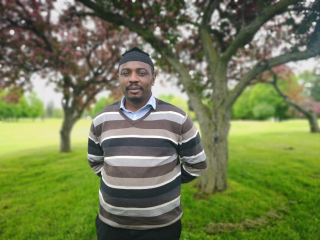 michael.boh [at] mcgill.ca (Email) | Dept. of Bioresource Engineering, McGill University
michael.boh [at] mcgill.ca (Email) | Dept. of Bioresource Engineering, McGill University
Dr. Boh is a Research Associate in the Ecological Engineering Research Group, at Macdonald Campus of McGill University. He oversees the running of the research activities of the AGGP2-033 program, organizes meetings and workshops and monitors the progress of the project to ensure that the objectives are met in timely manner. His research interest includes modelling biosolids management strategies and nutrient use efficiency.
For his full biography, visit his profile on the EcoEng Group People page.
Postdoctoral Researcher
Dr. Naseer Hussain
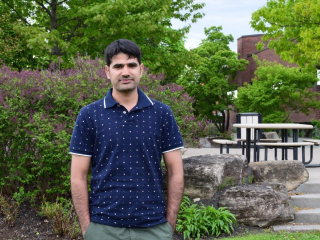 Title of Research: Biosolids’ impact on corn productivity, soil health and greenhouse gas emissions
Title of Research: Biosolids’ impact on corn productivity, soil health and greenhouse gas emissions
naseer.hussain [at] mail.mcgill.ca (Email) | Dept. of Natural Resource Sciences, McGill University
Dr. Hussain is estimating the greenhouse gas emissions from biosolids-amended soils. He is specifically looking on how the concentration gradient and the management practices of biosolids will influence the GHGs emissions form biosolids amended soils. He uses the static chamber method for measuring the GHGs flux. Dr. Hussain also assesses the potential of biosolids as nitrogen fertilizer source for silage corn production. He has a keen interest in studying the dynamic of the soil fauna, especially the earthworms, in biosolids fertilized agricultural soils.
PhD Candidates
Okenna Obi-Njoku
 Title of Research: Modelling greenhouse gas emissions (GHGe) from biosolids-fertilized soils in Canada
Title of Research: Modelling greenhouse gas emissions (GHGe) from biosolids-fertilized soils in Canada
okenna.obi-njoku [at] mail.mcgill.ca (Email )| Dept. of Bioresource Engineering, McGill University
Okenna's research centres around estimating GHGe from the use of municipal biosolids as a source of nitrogen in crop production. To do this, Okenna is using the DeNitrification and DeComposition (DNDC) model to assess the role of climate, soil and biosolids management methods GHGe. His work will generate emissions factors that will be used for monitoring and reporting emissions from agricultural use of biosolids. It will also provide insight on climate change mitigation strategies related to biosolids use.
Carmen Cecilia Roman Perez
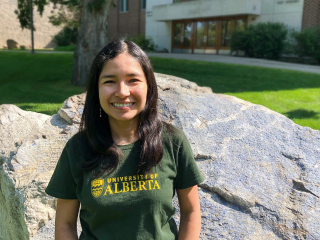 Title of Research: Assessing Land Biosolids Application: Greenhouse Gas Emissions, Nitrogen Dynamics and Crop Productivity
Title of Research: Assessing Land Biosolids Application: Greenhouse Gas Emissions, Nitrogen Dynamics and Crop Productivity
romanper [at] ualberta.ca (Email )| Dept. of Renewable Resources, University of Alberta
Biosolids are byproducts from municipal wastewater treatment plants. Land application of biosolids is beneficial for the productivity of agricultural and forestry ecosystems and for land reclamation. Earlier studies on the use of biosolids have focused on its effects on soil properties and crop productivity. The effect of biosolids application on nutrient use efficiency and emissions of greenhouse gases are not well understood. Carmen’s research aims to quantify biomass productivity and assess the efficacy of biosolids as source of nutrients for barley (Hordeum vulgare, L.) silage and the associated greenhouse emissions.
Emal Sabot
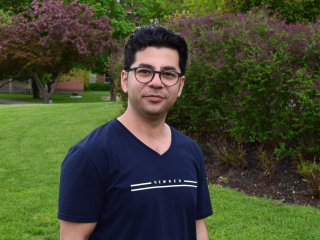 Title of Research: Response of mycorrhizal-plant association to fertilizer sources
Title of Research: Response of mycorrhizal-plant association to fertilizer sources
emal.sobat [at] mail.mcgill.ca (Email) | Dept. of Natural Resource Sciences, McGill University
Emal Sobat studies arbuscular mycorrhizal fungi, a symbiont of plant roots. He is examining the response of the mycorrhizal-plant association to fertilizer sources (biosolids, inorganic fertilizers). The goal of this work is to identify the soil fertility conditions that promote the mycorrhizal symbiosis and increase corn production under drought stress.
Masters Students
Liam Fitzpatrick
 Title of Research: Using automated chambers to complement manual measurement of greenhouse gas fluxes from agricultural soil
Title of Research: Using automated chambers to complement manual measurement of greenhouse gas fluxes from agricultural soil
liam.fitzpatrick2 [at] mail.mcgill.ca (Email )| Dept. of Bioresource Engineering, McGill University
Manually-operated static chambers are widely used for measuring greenhouse gas fluxes from agricultural soils. This method is laborious and measurements are infrequent. As such, short-term fluxes due to weather changes or soil disturbances associated with field management are not captured. In contrast, automated chambers systems can continually measure greenhouse gas fluxes from soils, but they are costlier to procure and operate. Liam’s research is focused on developing a hybrid system to leverage the advantages of both types of chamber and generate a flux estimation factor that could be used to compensate for the low temporal resolution of data collected with manual chambers only.
Zheya Lin
 Title of Research: Evaluation of Three Types of Municipal Biosolids on Soil Fertility and Corn Production
Title of Research: Evaluation of Three Types of Municipal Biosolids on Soil Fertility and Corn Production
MSc Student
Zheya.Lin [at] dal.ca (Email )| Dept. of Plant, Food, and Environmental Sciences, Dalhousie University
Land application of biosolids as a source of crop fertility and soil organic matter can be viewed as a sustainable approach to maintain soil productivity. Plant growth can be partially supported through the use of these amendments, thereby minimizing reliance on chemical fertilizers. Zheya’s research is focused on the evaluation of all treatments in the field based on management associated with surface vs. incorporation of biosolids and application of biosolids with urea supplementation. Additional agronomic parameters, including crop yield and plant nutrient uptake, are being examined relative to the amendment rates to develop nutrient use efficiency indices.
Elissa Saliba
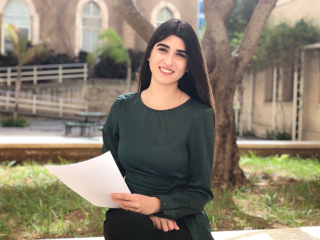 Title of Research: Life Cycle Assessment of agricultural use of biosolids as a fertilizer and soil organic amendment
Title of Research: Life Cycle Assessment of agricultural use of biosolids as a fertilizer and soil organic amendment
Elissa.Saliba [at] mail.mcgill.ca (Email )| Dept. of Bioresource Engineering, McGill University
Elissa’s research seeks to assess the environmental impacts associated with the processing, handling and land application of three different types of municipal biosolids: anaerobically digested, composted, and lime stabilized biosolids. Her research is a collaboration with the International reference center for the life cycle products, processes and services (CIRAIG), Polytechnique Montreal. The results of her research will support policy decisions with regards to the production and use of biosolids in crop production.
Gurwinder Singh
 Title of Research: Investigating the influence of biosolids application on carbon availability and nitrate accumulation and greenhouse gas emissions
Title of Research: Investigating the influence of biosolids application on carbon availability and nitrate accumulation and greenhouse gas emissions
GSingh [at] dal.ca (Email )| Department of Plant, Food, and Environmental Sciences, Dalhousie University
Gurwinder’s project focuses on measuring greenhouse gas emissions from soils and relating that to nitrogen availability in the soil. He is using anion exchange membranes to measure the rate of nitrate accumulation in the soils over the growing season. His work is driven by earlier research that has shown that amount of NO3- in the soil influence influences the amount of N2O emissions.
Undergraduate interns
Sreedurga Cherukumalli
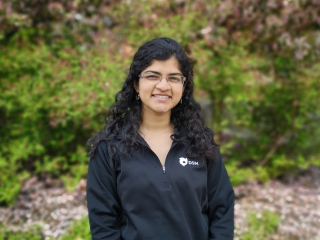 Title of Research: Determination of the nitrogen status of biosolids-fertilized maize (Zea mays, L.) using a chlorophyll meter
Title of Research: Determination of the nitrogen status of biosolids-fertilized maize (Zea mays, L.) using a chlorophyll meter
Undergraduate student 2019 summer intern
sreedurga.cherukumalli [at] mail.mcgill.ca (Email )| Dept. of Bioresource Engineering, McGill University
Sreedurga is an NSERC undergraduate student research award (USRA) intern with the Ecological Engineering Research Group, McGill University. Leaf chlorophyll concentration provides important information on chloroplast development, nitrogen content and overall plant health. Supplying nitrogen through municipal biosolids only or in combination with commercial urea can have an implication on the availability and utilization efficiency of growing maize plants during early vegetative growth. Sreedurga will use a Soil Plant Analysis Development (SPAD) chlorophyll meter, a non-destructive technique to evaluate the effect of nitrogen supply amount through biosolids on early physiological conditions of maize plants.
Youngsoo Lee
 Title of Research: Closure time optimization of automated gas chambers used in measuring GHG emissions from agricultural soils
Title of Research: Closure time optimization of automated gas chambers used in measuring GHG emissions from agricultural soils
Undergraduate student 2019 summer intern
youngsoo.lee [at] mail.mcgill.ca (Email )| Dept. of Bioresource Engineering, McGill University
Youngsoo is an NSERC undergraduate student research award (USRA) intern with the Ecological Engineering Research Group, McGill University. His research interests include organic waste management, management of ecosystem services, renewable energy and material flows and greenhouse gas emissions analysis. His internship focuses on optimizing closure time and frequency of automated gas chambers used for measuring greenhouse gas fluxes from agricultural soils amended with different types of biosolids. This work will ensure measurement consistency and improve the quality of data generated.
Agricultural Greenhouse Gases Project Summer Intern Alumni
Erik Gallego - John Abbott College summer intern (2019)
Jiaying (Seven) Liu - undergraduate summer intern, South China Agricultural University (2019)
Oliver Wockner - BREE U3 summer intern (2019)
Mai (Miley) Yingwen - undergraduate summer intern, South China Agricultural University (2019)
Yixuan (Angelina) Zou - undergraduate summer intern, South China Agricultural University (2019)
Shuqi (Kay) Zheng - undergraduate summer intern, South China Agricultural University (2018)
Yuanrou (Sammy) Lin - undergraduate summer intern, South China Agricultural University (2018)
